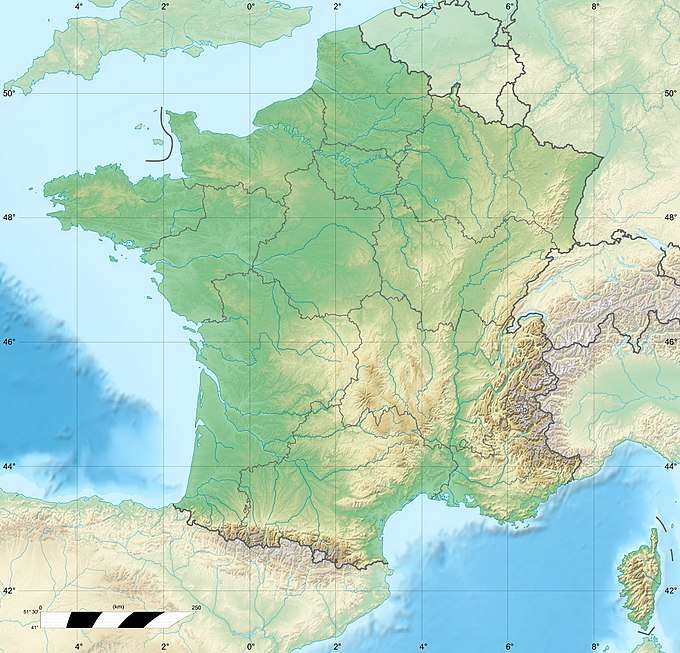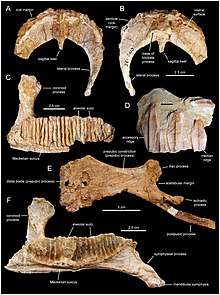Marnes d'Auzas Formation
The Marnes d’Auzas Formation (Auzas marls) is a geological Formation in southwestern France (departments of Ariège and Haute-Garonne) whose strata date back to the Late Maastrichtian.[1] It is about 100 metres thick and consists primarily of marls with some interbeds of sandstones.[1] It corresponds to sediments whose depositional environment evolved from the paralic domain (coastal lagoons, tidal marsh, tidal muddy channel) at the base of the formation, towards a more continental domain (alluvial plain, fluvial channels) in its upper part.[1] The Marnes d’Auzas Formation was deposited in the west coast of the former Ibero-Armorican Island, which included much of France and Spain.[2]
| Marnes d’Auzas Formation Stratigraphic range: Late Cretaceous (Late Maastrichtian) ~67.5–66 Ma | |
|---|---|
| Type | Geological formation |
| Underlies | Aurignac Formation |
| Overlies | Jadet Calcarenites Formation |
| Thickness | About 100 m |
| Lithology | |
| Primary | Marls |
| Other | Sandstones |
| Location | |
| Coordinates | 43°25′N 1°30′E |
| Region | Europe |
| Country | |
 Marnes d'Auzas Formation (France) | |
Vertebrate paleofauna

Holotype maxilla of Canardia garonnensis from the site of Tricouté 3 in the basal part of the Marnes d'Auzas Formation.[3]
- Theropods:
- Theropoda indet. (a medium-sized form only known by a tooth)[1]
- Dromaeosauridae indet.[4][1]
- Hadrosaurs:
- Sauropods:
- Titanosauria indet.[4][1] (compared to the Ibero-Armorican titanosaurs from the Campanian and early Maastrichtian times, the teeth of this form are more like those of Atsinganosaurus than those of Ampelosaurus or Lirainosaurus.[5]
- Bird:
- Enantiornithes indet.[4][1]
- Mammals:
- Pterosaurs:
- Azhdarchidae indet. (only known by a very large cervical vertebra suggesting an individual with a wing-span of 9 m) [6][1]
- Turtle:
- Squamata:
- Mosasauroidea indet.[4][1] (only known by a vertebra first attributed to a Varanoidea, would actually be a freshwater mosasaur)[8]
- ? Amphisbaenia indet.[4][1]
- cf. Teiidae indet.[1]
- Crocodylia:
- Thoracosaurus neocesariensis[9][4][1] (according to Christopher Brochu, the species from the Marnes d'Auzas represents a distinct taxon from T. neocesariensis)[10]
- cf. Musturzabalsuchus sp.[4][1]
- Amphibia:
- Fish:
- Palaeogaleus sp.[1]
- Rhinobatos sp.[1]
- Rhombodus binkhorsti[1]
- Coupatezia sp.[1]
- cf. Pycnodus sp.[1]
- Lepisosteidae indet.[4][1]
- Phyllodontidae indet.[4][1]
- Sparidae indet.[4][1]

Bones of an indeterminate Lambeosaurinae from the site of Cassagnau 2 in the middle part of the Marnes d'Auzas Formation. Predentary in dorsal (A) and ventral (B) views. Partial left dentary in medial view (C). Dentary tooth crowns in lingual view (D). Complete left pubis in lateral view (E). Left dentary in medial view (F), belonging to the same individual as the predentary.[3]
gollark: I'll try Codex.
gollark: I might implement actual MCTS.
gollark: The current implementation is just """monte carlo tree search""" which plays 128 games entirely at random and sees how many it wins. I tried minimax/α-β pruning but those caused RAM implosions.
gollark: That would be effort, though.
gollark: Implementing a good "AI" opponent is proving surprisingly hard since I can't do tree-searchy things with any significant depth or the browser just runs out of memory.
See also
- List of dinosaur-bearing rock formations
References
- Laurent, Y. (2003). "Les faunes de vertébrés continentaux du Maastrichtien supérieur d'Europe : systématique et biodiversité". Strata (41): 1–81.
- Csiki-Sava, Z.; Buffetaut, E.; Ősi, A.; Pereda-Suberbiola, X.; Brusatte, S.L. (2015). "Island life in the Cretaceous-faunal composition, biostratigraphy, evolution, and extinction of land-living vertebrates on the Late Cretaceous European archipelago". ZooKeys (469): 1–161. doi:10.3897/zookeys.469.8439. PMC 4296572. PMID 25610343.
- Prieto-Márquez, A.; Dalla Vecchia, F.M.; Gaete, R.; Galobart, À. (2013). "Diversity, Relationships, and Biogeography of the Lambeosaurine Dinosaurs from the European Archipelago, with Description of the New Aralosaurin Canardia garonnensis". PLOS ONE. 8 (7): e69835. Bibcode:2013PLoSO...869835P. doi:10.1371/journal.pone.0069835. PMC 3724916. PMID 23922815.
- Laurent, Y.; Bilotte, M.; Le Loeuff, J. (2002). "Late Maastrichtian continental vertebrates from southwestern France: correlation with marine fauna". Palaeogeography, Palaeoclimatology, Palaeoecology. 187 (1–2): 121–135. Bibcode:2002PPP...187..121L. doi:10.1016/S0031-0182(02)00512-6.
- Garcia, G.; Amicot, S.; Fournier, F.; Thouand, E.; Valentin, X. (2010). "A new Titanosaur genus (Dinosauria, Sauropoda) from the Late Cretaceous of southern France and its paleobiogeographic implications". Bulletin de la Société Géologique de France. 181 (3): 269–277. doi:10.2113/gssgfbull.181.3.269.
- Buffetaut, E.; Laurent, Y.; Le Loeuff, J.; Bilotte, M. (1997). "A terminal Cretaceous giant pterosaur from the French Pyrenees". Geological Magazine. 134 (4): 553–556. Bibcode:1997GeoM..134..553B. doi:10.1017/S0016756897007449.
- Pérez-García, A.; Ortega, F.; Murelaga, X. (2012). "A new genus of Bothremydidae (Chelonii, Pleurodira) in the Cretaceous of southwestern Europe". Geobios. 45 (2): 219–229. doi:10.1016/j.geobios.2011.03.001.
- Garcia, G.; Bardet, N.; Houssaye, A.; Pereda-Suberbiola, X.; Valentin, X. (2015). "Mosasauroid (Squamata) discovery in the Late Cretaceous (Early Campanian) continental deposits of Villeveyrac-L'Olivet, Southern France – Découverte de Mosasauroidea (Squamata) dans le Crétacé supérieur (Campanien inférieur) continental de Villeveyrac – L'Olivet, sud de la France". Comptes Rendus Palevol. 14 (6–7): 495–505. doi:10.1016/j.crpv.2015.05.002.
- Laurent, Y.; Buffetaut, E.; Le Loeuff, J. (2000). "Un crâne de Thoracosaurine (Crocodylia, Crocodylidae) dans le Maastrichtien supérieur du sud de la France". Oryctos (3): 19–27.
- Brochu, C.A. (2004). "A new Late Cretaceous gavialoid crocodylian from eastern North America and the phylogenetic relationships of Thoracosaurs". Journal of Vertebrate Paleontology. 24 (3): 610–633. doi:10.1671/0272-4634(2004)024[0610:ANLCGC]2.0.CO;2.
This article is issued from Wikipedia. The text is licensed under Creative Commons - Attribution - Sharealike. Additional terms may apply for the media files.